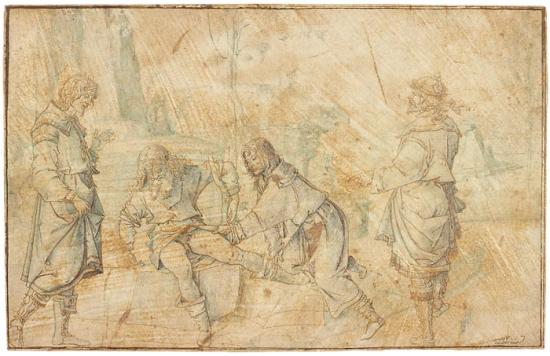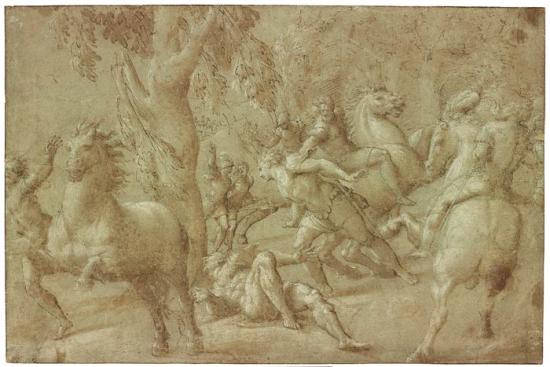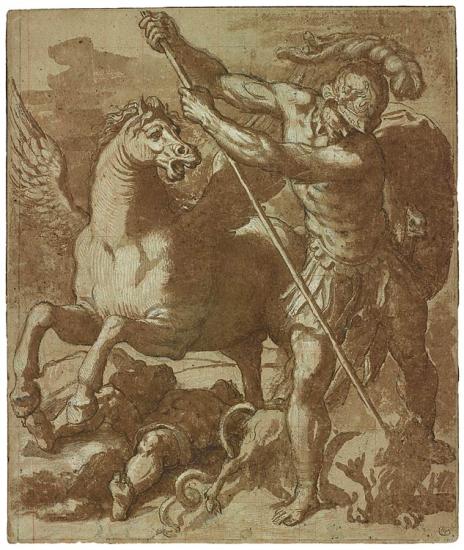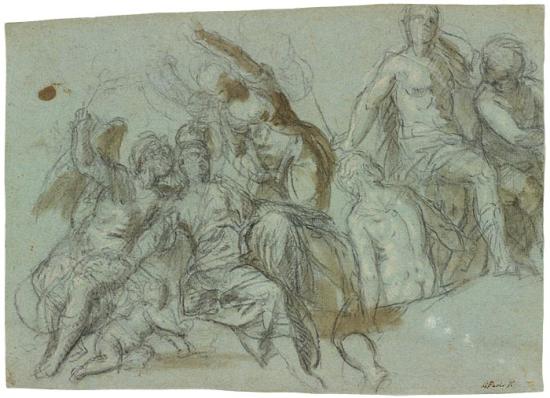Patronage
The astonishing creative efflorescence of sixteenth-century Venice would not have been possible without a rich network of civic, religious, and governmental support. The republic was governed by a hereditary ruling class under the leadership of a doge—generally a member of the inner circle of powerful local families whom the aristocracy appointed for life. Venice celebrated itself and proclaimed its civic ideals in large paintings by Titian, Veronese, and Federico Zuccaro that lined the walls of the Doge's Palace. Wealthy lay confraternities, called scuole, provided another essential layer of support and promoted a distinctively Venetian style of large narrative composition. Finally, a powerful and enlightened aristocracy commissioned works for their private dwellings in town and on the mainland. Whereas Giovanni Bellini and his followers had primarily produced altarpieces and religious images for personal devotion, this new generation of Venetian artists also met the demands of their expanding clientele for secular subject matter.
Bartolomeo Montagna

Drunkenness of Noah
Inscribed at lower right, in pen and brown ink, albordür[er] [i.e., Alberto Dürer].
Purchased by Pierpont Morgan, 1909
Patronage
The astonishing creative efflorescence of sixteenth-century Venice would not have been possible without a rich network of civic, religious, and governmental support. The republic was governed by a hereditary ruling class under the leadership of a doge—generally a member of the inner circle of powerful local families whom the aristocracy appointed for life. Venice celebrated itself and proclaimed its civic ideals in large paintings by Titian, Veronese, and Federico Zuccaro that lined the walls of the Doge's Palace. Wealthy lay confraternities, called scuole, provided another essential layer of support and promoted a distinctively Venetian style of large narrative composition. Finally, a powerful and enlightened aristocracy commissioned works for their private dwellings in town and on the mainland. Whereas Giovanni Bellini and his followers had primarily produced altarpieces and religious images for personal devotion, this new generation of Venetian artists also met the demands of their expanding clientele for secular subject matter.
The painter and architect Bartolomeo Montagna, who is first documented in Venice in 1469, was a member of Giovanni Bellini's workshop. In the present sheet, one of Noah's sons is shown piously attempting to cover his drunken father's nudity, while another draws attention to this embarrassing state. The drawing has been associated with a commission of 1482 for the Scuola Grande di San Marco, Venice, for paintings of the flood and "other related events" from the Book of Genesis. The paintings were destroyed in a fire in 1485.
Giovanni Antonio Pordenone

Conversion of St. Paul, early 1530s
Gift of J. P. Morgan, Jr., 1924
This drawing is the modello for a well-known painting by Pordenone, now lost, that must have impressed critics and artists alike through the virtuosity of its radically foreshortened figures and its splendid sense of movement and energy. It spawned several copies, Pordenone repeated sections of it for Venetian collectors, and Tintoretto used it as inspiration for a painting of the same subject (National Gallery of Art, Washington).
Pordenone's composition adapted elements from a tapestry cartoon of the same subject by Raphael, which was displayed in the house of Cardinal Domenico Grimani in Venice.
Patronage
The astonishing creative efflorescence of sixteenth-century Venice would not have been possible without a rich network of civic, religious, and governmental support. The republic was governed by a hereditary ruling class under the leadership of a doge—generally a member of the inner circle of powerful local families whom the aristocracy appointed for life. Venice celebrated itself and proclaimed its civic ideals in large paintings by Titian, Veronese, and Federico Zuccaro that lined the walls of the Doge's Palace. Wealthy lay confraternities, called scuole, provided another essential layer of support and promoted a distinctively Venetian style of large narrative composition. Finally, a powerful and enlightened aristocracy commissioned works for their private dwellings in town and on the mainland. Whereas Giovanni Bellini and his followers had primarily produced altarpieces and religious images for personal devotion, this new generation of Venetian artists also met the demands of their expanding clientele for secular subject matter.
Giuseppe Porta, called Salviati

Bellerophon Killing the Chimera
Gift of Janos Scholz, 1973
Porta left Rome with his master, Francesco Salviati—whose name he later assumed—and arrived in Venice in July 1539. In that year he executed his most important commission in fresco, an ambitious ceiling for the Sala dell'Anticollegio in the Palazzo Ducale, which was destroyed by fire in 1574. Although he did not develop a pronounced individual style, Porta is partially responsible for bringing central Italian Mannerism to Venice.
This drawing is thought to be the study for a lost fresco painted on the facade of Nicolo Bernardo's house in Campo di San Polo, Venice.
Patronage
The astonishing creative efflorescence of sixteenth-century Venice would not have been possible without a rich network of civic, religious, and governmental support. The republic was governed by a hereditary ruling class under the leadership of a doge—generally a member of the inner circle of powerful local families whom the aristocracy appointed for life. Venice celebrated itself and proclaimed its civic ideals in large paintings by Titian, Veronese, and Federico Zuccaro that lined the walls of the Doge's Palace. Wealthy lay confraternities, called scuole, provided another essential layer of support and promoted a distinctively Venetian style of large narrative composition. Finally, a powerful and enlightened aristocracy commissioned works for their private dwellings in town and on the mainland. Whereas Giovanni Bellini and his followers had primarily produced altarpieces and religious images for personal devotion, this new generation of Venetian artists also met the demands of their expanding clientele for secular subject matter.
Paolo Veronese

Group of Figures for a Ceiling Decoration
Inscribed at lower right, in pen and brown ink, di Paolo V.
Purchased as the gift of the Fellows with the special assistance of Mrs. Gerrit P. Van de Bovenkamp, 1981
Veronese's secular history paintings fall into two groups: his state commissions for the Ducal Palace and St. Mark's Library, and his decoration of villas and palaces belonging to Venetian nobility. His greatest accomplishment of the first group is the Triumph of Venice in the Sala del Maggior Consiglio. At the left of this exploratory sketch for the project, the figure of Venice is being crowned by Victory.
Veronese frequently used chalk after arriving in Venice in 1553, although pen and ink remained his preferred medium.
Patronage
The astonishing creative efflorescence of sixteenth-century Venice would not have been possible without a rich network of civic, religious, and governmental support. The republic was governed by a hereditary ruling class under the leadership of a doge—generally a member of the inner circle of powerful local families whom the aristocracy appointed for life. Venice celebrated itself and proclaimed its civic ideals in large paintings by Titian, Veronese, and Federico Zuccaro that lined the walls of the Doge's Palace. Wealthy lay confraternities, called scuole, provided another essential layer of support and promoted a distinctively Venetian style of large narrative composition. Finally, a powerful and enlightened aristocracy commissioned works for their private dwellings in town and on the mainland. Whereas Giovanni Bellini and his followers had primarily produced altarpieces and religious images for personal devotion, this new generation of Venetian artists also met the demands of their expanding clientele for secular subject matter.